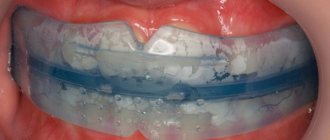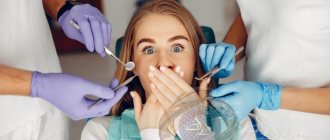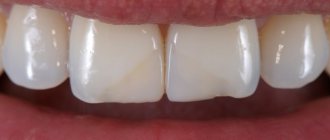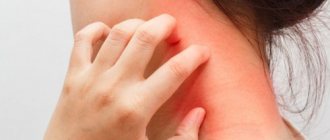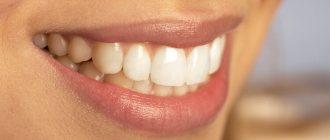A physiological, that is, correct, bite in dentistry is considered to be one that allows the teeth to perform all functions efficiently. Normally, the antagonist teeth of the upper and lower jaws should touch, located almost opposite each other. In this case, the upper jaw should be slightly pushed forward to ensure slight overlap of the lower teeth with the upper ones. With a correct bite, the upper dental arch has the shape of half an ellipse, and the lower one has the shape of a parabola; the teeth themselves are located at a slight inclination towards the oral cavity.
In practice, correct dentition, a striking example of which is demonstrated by the ideal Hollywood smile formed by a dentist, is rare. Therefore, several types of physiological occlusion are considered to be the norm, to which some experts include a straight bite.
What is a straight bite
Direct bite refers to the closure of the dentition, in which the lower edges of the upper and lower teeth touch.
If a person has straight teeth, then such a smile seems flawless. Often such a bite appears in advertisements for toothpastes or chewing gum, which misleads viewers. In fact, direct bite is a variant of pathology, despite the above advantages. If you find your child's teeth are closing in this way, you should contact your dentist as soon as possible. Otherwise, serious complications will arise.
Ways to correct deformity
To correct the bite in adults, various orthodontic appliances and devices are used. This treatment promotes the displacement of individual teeth, restores the correct position of the upper and lower jaw and dentition.
Braces
If the question is how to correct a person’s malocclusion, you should pay attention to a correction method such as braces. They look like plates connected to each other by an arc. Fixation to the teeth occurs from the outside or inside.
Braces or staples act on the dentition mechanically - they slowly move the roots and stretch the tissue around them. As a result, the position of individual teeth and the entire row changes, which is effective for complex anomalies.
There are the following types of bracket systems:
- According to the method of attaching the arch to the bracket: ligature - involves connection using rubber bands and non-ligature - connected using locks or latches.
- According to the place of fixation: vestibular - attached to the outer surface of the teeth and lingual - attached to the inner surface of the teeth.
- According to the material from which they are made: metal - the most reliable, but look unaesthetic; sapphire and ceramic - the most expensive, reliable and aesthetic; plastic - the most impractical, they break quickly.
Once the correction with braces is completed, the treatment is not completed. Next comes the retention period, when the patient needs to wear a retainer or a removable mouth guard constantly, and sometimes throughout his life. This is a thin metal permanent thread that is fixed to the teeth from the inside on the tongue side.
Mouthguards
Dental aligners or aligners are a removable structure made of transparent silicone, polyurethane, and thermoplastic. To correct deformities of the jaws and teeth, mouth guards must be worn constantly and removed only when eating.
The design is made individually according to the size of the patient’s jaw. The trays are replaced at each stage of therapy, approximately every 2 to 3 weeks.
Advantages of aligners:
- almost invisible to others;
- do not cause discomfort when wearing;
- do not damage the enamel.
The disadvantage is that it is impossible to correct serious bite pathologies using mouth guards.
Trainers
Trainers are transparent, removable structures made of biosilicone. Outwardly they resemble dental guards, but are more massive. At the beginning of treatment, soft structures are selected and gradually replaced with hard ones. They have a standard shape or can be made individually.
They are most effective in children, but are also used in adults, if it is necessary to normalize the position of individual teeth, and in case of slight deformation of the jaws. Allows you to eliminate impaired breathing and swallowing functions, restore clarity of speech, and stimulate the proper functioning of the facial muscles.
The advantage of trainers is that they only need to be put on before bed and left on all night. During the day you can wear it for only 2 – 4 hours.
Orthodontic plates
What to do if the malocclusion is not very pronounced? In this case, your doctor may recommend an orthodontic plate. This design is installed on the palate and gums, fixed to the teeth using special hooks.
The plate does not cause discomfort, but is more effective in correcting deformities in childhood. In adults, it is often used at the preparation stage before installing braces.
Myogymnastics
Myogymnastics is not an independent method of correcting dental defects, but an additional one. It is impossible to completely correct the bite of an adult with its help, but it is quite possible to correct the curvature of the teeth. The effectiveness of exercises is highest when wearing orthodontic corrective structures.
Performing myogymnastics strengthens the facial muscles well. Exercises should be performed every day during the entire treatment period.
Surgical correction
Many patients, knowing the dangers of malocclusion, decide to undergo surgery. Surgical intervention is indicated for severe jaw deformation and pronounced defects. It is carried out in the following cases:
- injuries to the jaws and face;
- crossbite, causing pronounced facial asymmetry;
- open bite, causing impaired chewing function and serious speech defects;
- chin dysplasia.
The operation is performed under anesthesia. This is the fastest and most effective way to get rid of deformation, which is noticeable in the photo before and after treatment. The downside is the long rehabilitation period, up to a month or more. For several weeks, you must strictly follow the doctor’s recommendations and eat only liquid food through a tube, as special splints will be placed on your jaws.
The choice of an orthodontic device for bite correction is made by the doctor, based on individual characteristics - the type and severity of the deformation, its consequences. The patient must follow the requirements of the chosen method throughout the entire treatment period; this is the only way to obtain the desired effect.
Is a straight bite normal?
If we are talking about a physiological bite, then in this case the upper row of teeth slightly covers the lower one. This does not happen with a straight bite.
Such occlusion cannot be considered normal, since it is fraught with the appearance of a number of defects and disorders, despite a visually ideal smile (if the person has straight teeth).
Important: straight bite is bad . Here are some problems that people with a straight bite experience:
- With a direct bite, the lower jaw gradually moves forward, which is why the bite becomes progenic.
- The enamel wears off at an accelerated rate due to heavy loads on the teeth.
- The jaw also experiences heavy loads, which is fraught with pain and problems in the functioning of the temporomandibular temple.
- Increased risk of developing caries and periodontal disease.
Types of malocclusion
In practice, there are several types of anomalies. The bite happens:
- distal (when the jaw protrudes forward from above, and the lower jaw is underdeveloped);
- mesial (teeth move forward from below);
- open (some teeth in a row do not close together);
- deep (the jaw on top “sits” on the lower jaw by more than half);
- cross (displacement of rows in the horizontal plane);
- dystopia (molars are positioned incorrectly).
Features of direct bite
The main feature of a direct bite is the parallel closure of the jaws, in which the upper incisors do not overlap the lower ones. Other features of a straight bite include:
- increased load on the front teeth;
- violation of the proportions of the lower part of the face (occurs over time if the bite is not corrected);
- clicks when opening and closing the mouth associated with dysfunction of the temporomandibular joint;
- pain in the cervical region and headaches arising from problems with the jaw joints.
Causes of direct bite
The main reasons for direct closure of the dentition include:
- Heredity . The position of the jaws and the placement of teeth in a straight bite are often determined by hereditary factors. This type of pathology is more difficult to correct than others.
- Disorders of intrauterine development . Much depends on the condition of the pregnant woman. Bad habits, hypovitaminosis, stress and other unfavorable factors negatively affect the health of the fetus, including the condition of the dental system.
- Artificial feeding and pacifiers . Often, a child develops malocclusion when using pacifiers for a long time.
- Bad habits in a child . Habits such as thumb sucking and other objects negatively affect bite formation. It is important to wean your child off this as early as possible.
Diagnosis of direct bite
Typically, an orthodontist can make a diagnosis based on an external examination alone. However, to clarify the diagnosis and select a treatment method, the patient undergoes additional instrumental studies:
- Occlusiogram - determination of areas of contact between the edges of the teeth. It is performed using special wax plates.
- X-ray of the facial part of the head . Performed in frontal and lateral projection.
- Panoramic radiography (orthopantomography).
- Electromyography is a study of the muscular system.
Treatment of direct bite
Straight bite is a problem that can be successfully treated. Modern dentistry has a solid arsenal of techniques for correcting all types of non-physiological bites, including direct bites. Today, treatment of direct bite in adults and children is carried out using special orthodontic structures:
- Braces . This is the main method of correction, allowing you to achieve the desired result relatively quickly. Treatment with braces is recommended to begin in adolescence, when the dental system is not yet fully formed. The type of braces, as well as the duration of wearing them, is selected by the doctor.
- Mouth guards and retainers. Retainers are worn after braces. These designs allow you to consolidate the results achieved with braces. However, both mouthguards and retainers help avoid the severe consequences of a direct bite. In particular, this is excessive wear of teeth.
Prices
| Name of service | price, rub. |
| Preliminary orthodontic analysis: taking an impression from one row of teeth, making a working model, orthopantomogram analysis, photographic examination | from 4000 |
| Correction of malocclusions and tooth position using a simple plate | from 19600 |
| Fixed appliance (braces) for correcting the position of the front teeth | from 40000 |
| Standardized positioners (Myobrace, LM-activator) | from 14000 |
| Vestibular plates (Dr. Hinz Dental) | from 7000 |
| Repeated (control) visits during treatment with removable devices | from 890 |
| Repeated (control) visits during treatment with fixed devices | from 1740 |
| Repairing a removable device | from 2620 |
Consequences
The main danger of a direct bite is accelerated wear of teeth. This happens despite the fact that enamel is considered one of the strongest biological materials. With constant contact between the cutting surfaces of the teeth, hard tissues are quickly destroyed, unable to withstand the load.
Let's look at the typical consequences of a straight bite:
- Toothache . With the destruction of hard tissues, teeth begin to hurt over time. It is advisable not to let it get to this point, but to consult a doctor as soon as a defect is discovered.
- Tooth decay . Sometimes people with a straight bite refuse to acknowledge the problem until their teeth are completely destroyed. In this case, the only way to help is with prosthetics.
- Aesthetic problems . Initially, a straight bite really looks beautiful. However, as teeth wear down, the smile deteriorates. The length of teeth can be reduced by 35-40%, which leads to aesthetic defects.
- Caries . Destruction of hard tooth tissues significantly increases the risk of developing caries. In turn, caries only accelerates the process of destruction due to the action of organic acids secreted by bacteria.
- Periodontal disease . The addition of an infection is fraught with the development of gum disease. Against the background of tooth wear and caries, periodontal disease often develops.
- Disorders of the temporomandibular joint . This leads to characteristic clicking sounds when opening and closing the mouth. Later, when working with the jaws, pain occurs. In addition, dysfunction of the temporomandibular joint leads to deterioration of hearing and diction.
Important . It is difficult to predict the above complications. In this regard, doctors strongly recommend correcting malocclusion as soon as possible.
How is bite correction done in adults?
One of the options for correcting your bite and straightening your teeth is permanent braces. Lock-braces are attached to the enamel, an arch is placed in special grooves, which gradually moves the teeth in a given direction.
Sign up for free 3D modeling of your future smile!
Make an appointment
*By making an appointment you consent to the processing of your data
Modern technologies do not stand still, and now not only metal braces are available to patients in dental clinics. You can choose more aesthetic systems made of ceramics and medical sapphire or lingual braces, which are attached to the inner surface of the teeth. However, treatment with braces still cannot be called invisible and comfortable. The patient must change his lifestyle, diet, and use a whole range of oral care products. Adult patients often refuse orthodontic treatment altogether at the mere mention of braces, considering them uncomfortable and unaesthetic.
Prevention
We can talk about preventive measures regarding direct bite if the child does not have a genetic predisposition to this anomaly. You can reduce the likelihood of developing an abnormal bite by adhering to the following recommendations:
- Adequate nutrition for a woman during pregnancy . It is important that a woman consumes enough calcium. This element is found in broccoli, dairy products, and sesame. A sufficient amount of calcium is important for the health of your baby's bones and teeth.
- Natural feeding. Keep your baby breastfed for as long as possible.
- No bad habits. These include thumb sucking or an obsession with pacifiers and bottles with pacifiers. Often against this background, children develop mouth breathing, which changes their bite.
- Balanced nutrition for a child . The child’s menu should have enough protein, vitamins and minerals. Try to minimize the consumption of simple carbohydrates (sugar, sweets, flour).
- Regular examinations with a doctor . Take your child to see a doctor twice a year.
Preventive measures
The risk of developing an anomaly in a child can be reduced to a minimum by the following measures:
- See your doctor regularly during pregnancy.
- Eat nutritiously during pregnancy (particular attention should be paid to foods containing large amounts of calcium).
- Breastfeed your baby.
- Control the baby's breathing (it should be nasal).
- Wean off the pacifier in a timely manner. Its period of use should be limited to three years.
- Take your child to the dentist regularly.
What is the period of mixed dentition, and what parents need to pay attention to.
In this article we will tell you all the most important things about senile progeny.
Follow the link https://orto-info.ru/zubocheliustnye-anomalii/okklyuzii/profilaktiki.html to learn more about the kit for the prevention of malocclusions.
Treatment of direct bite at the CIS clinic
At the Israeli Dentistry Center, straight bites are treated by experienced orthodontists. Our clinics on the Left Bank (Kyiv) are equipped with modern diagnostic equipment that allows us to establish an accurate diagnosis. Based on the data obtained, we select individual treatment for each patient.
Treatment with braces for direct bite: before and after
Correcting dental malocclusion with aligners
At the patient's request, we will provide treatment with Damon braces, but we will always offer a worthy alternative - removable Invisalign aligners. Only they guarantee truly invisible and comfortable correction of bites of any complexity.
Using Invisalign aligners, PROBLICUS orthodontists successfully treat all bite pathologies that can be corrected with braces. We were the first in Russia to work with aligners.
The results and timing of treatment with aligners are always predictable: our patients know on what day the bite correction will be completed. Even before treatment begins, the orthodontist shows the patient what his ideal smile will look like.
FAQ
Is it possible to correct a straight bite on your own?
On the Internet you can find various massage techniques and exercises that supposedly will help correct your bite. Such methods are not only ineffective, but also harmful. Under no circumstances should you resort to self-medication, especially when you do not know the exact diagnosis. To identify the problem and solve it, be sure to consult a doctor.
Is it possible to live with an incorrect bite?
It's possible, but not necessary. Above we have provided a list of complications and adverse consequences of direct bite. Any other malocclusion is also fraught with the development of complications. Correct bite is the key to healthy not only teeth, but also other organs and systems.
How does your bite affect your appearance?
It all depends on what kind of bite we are talking about. For example, a shortened upper jaw or a massive lower jaw makes the face angry and disproportionate.
How much does straight bite treatment cost?
The price depends on the volume and complexity of the treatment. As a rule, the cost of treatment is discussed in detail after diagnosis, when doctors understand the patient’s treatment strategy.
Benefits of Invisalign trays
- Efficiency. If you can correct your malocclusion with braces, Invisalign clear overlays will be just as effective, and often more effective.
- Convenience and easy care. The aligners can be removed while eating and brushing your teeth.
- Stealth. The aligners are made of durable and transparent plastic. They are invisible in conversation and in photographs.
- Comfort. When worn, the aligners do not create a feeling of discomfort in the mouth, do not rub the gums, and do not change the patient’s diction. It will take you a maximum of 2 hours to get used to them.
- Safety. Gums and tooth enamel are not damaged during treatment.
PROPRICUS dental specialists who will help you forget about dental malocclusion forever
Pokrovskaya Natalya Sergeevna
Head of the Department of Orthodontics
He specializes in solving problems with malocclusion using Invisalign aligners, and is involved in neuromuscular diagnostics and pediatric orthodontics. Work experience - 10 years.
